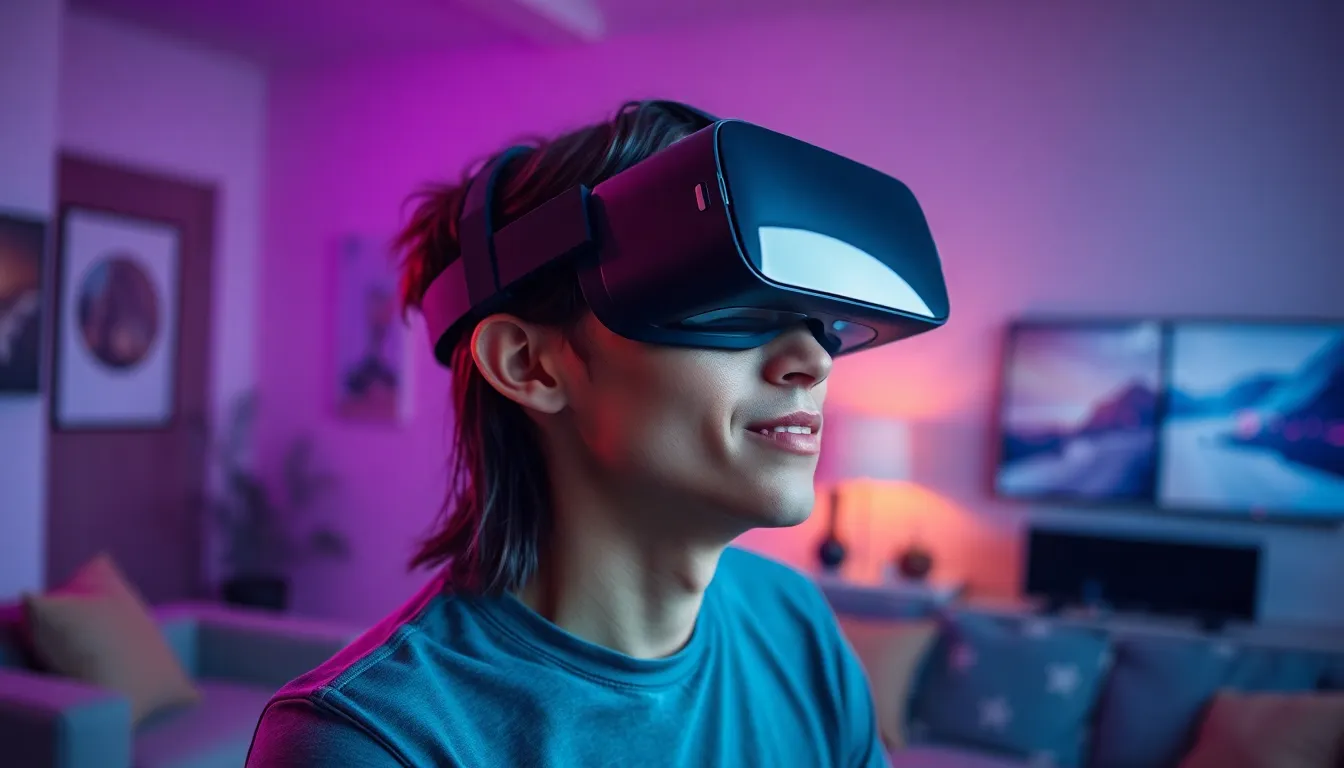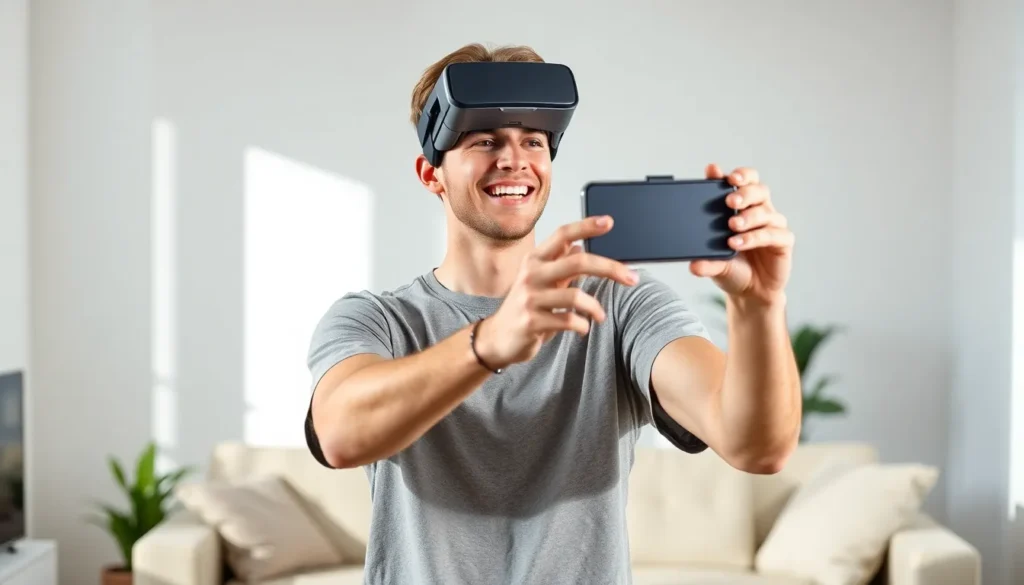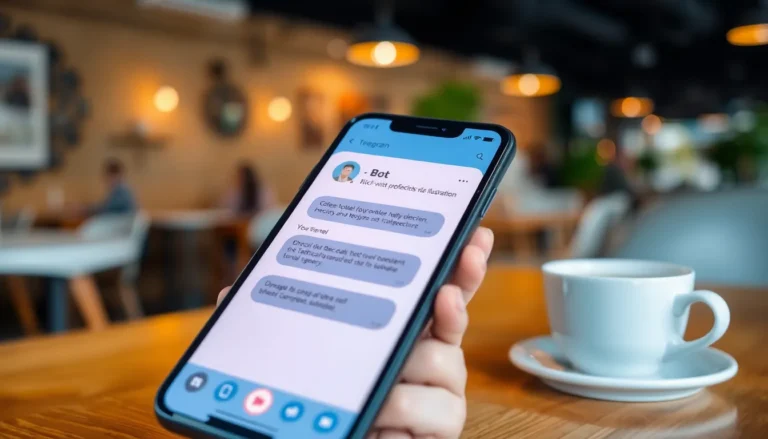Imagine slipping on a headset and being transported to a dazzling world where dragons roam and space battles rage—all while lounging on your couch in your pajamas. Mobile virtual reality isn’t just a futuristic dream; it’s here, and it’s ready to turn your mundane moments into epic adventures. With the power of smartphones and VR technology, anyone can dive into immersive experiences without breaking the bank or leaving their home.
Table of Contents
ToggleOverview of Mobile Virtual Reality
Mobile virtual reality (VR) leverages smartphones and portable devices to create immersive experiences. Users access virtual environments seamlessly, enhancing gaming, education, and training applications. Affordable VR headsets, such as those developed by Google and Samsung, play a crucial role in this accessibility.
Users engage with VR through various apps, enabling them to explore interactive experiences tailored for mobile platforms. Industries like real estate utilize mobile VR for virtual property tours, allowing potential buyers to view homes remotely. Education benefits from mobile VR as well, providing students with engaging learning experiences that facilitate knowledge retention.
Stats show that the global mobile VR market value reached approximately $3 billion in 2021, and it’s projected to grow significantly over the next few years. Increased smartphone penetration and advancements in AR/VR technology contribute to this rise. More developers are creating content tailored for mobile VR, expanding options for users.
Social interaction in mobile VR also rises, allowing users to meet and collaborate in virtual spaces. Platforms like VRChat and Rec Room provide social environments, enhancing user connectivity through shared experiences. Mobile VR has emerged as a powerful medium for storytelling, with experiences designed to immerse users in narratives.
As new advancements surface, mobile VR continues to redefine how individuals interact with technology and each other. The user experience typically revolves around accessibility, affordability, and engaging content, positioning mobile VR as a significant player in the future of entertainment and education.
Key Technologies Behind Mobile Virtual Reality

Mobile virtual reality relies on several key technologies to deliver immersive experiences. These technologies enhance the accessibility and functionality of VR for smartphone users.
Display and Optics
Display technologies play a crucial role in mobile VR. High-resolution screens create sharp images that captivate users. OLED and LCD panels, common in smartphones, provide vibrant colors and deep contrasts. Advanced lenses are also vital as they optimize the viewing experience, reducing distortion and enhancing field of view. Headsets compatible with smartphones utilize these displays, allowing for seamless integration. Some popular models include Google Cardboard and Samsung Gear VR, which leverage existing smartphone technology to deliver high-quality visuals.
Motion Tracking
Motion tracking significantly enhances interaction within mobile VR environments. Inertial sensors, commonly found in smartphones, enable precise head tracking. Accelerometers and gyroscopes work together to detect orientation and movement, creating a more immersive experience. External cameras and sensors, like those in the Oculus Quest, can also track player movement in real-time. These technologies ensure users can explore virtual spaces naturally. With accurate motion tracking, mobile VR experiences become more engaging, immersing users in the virtual world while maintaining a sense of presence and authenticity.
Popular Mobile Virtual Reality Devices
Mobile virtual reality devices offer immersive experiences that revolutionize how users engage with content. Smartphones and dedicated headsets make accessing these experiences simple and accessible.
Smartphones and Headsets
Smartphones like the Samsung Galaxy series and Google Pixel models support various mobile VR applications, integrating high-quality displays with powerful processors. Samsung Gear VR serves as a prominent headset, connecting seamlessly with select Galaxy devices for an enhanced visual experience. Google Cardboard remains popular for its affordability and versatility, allowing users to experience virtual reality with minimal investment. Oculus Quest 2 also makes a significant impact, featuring standalone capabilities that eliminate the need for a smartphone, while incorporating advanced tracking technology. These devices empower users to immerse themselves in interactive virtual worlds, ensuring compatibility with a broad range of applications.
Notable Applications and Games
Mobile virtual reality showcases a variety of applications and gaming experiences. Platforms like VRChat promote social interaction, allowing users to connect and share experiences in virtual spaces. Google Earth VR enables exploration of a vast array of locations globally, facilitating educational opportunities through immersive geography lessons. Popular games such as “Beat Saber” engage players with rhythm-based challenges, drawing vast audiences due to their addictive gameplay. “Richie’s Plank Experience” offers users a unique chance to confront their fears through thrilling high-rise scenarios. Various applications make mobile VR versatile, suitable for education, training, and entertainment purposes.
Advantages of Mobile Virtual Reality
Mobile virtual reality offers powerful benefits that enhance user experiences and interactions.
Accessibility and Convenience
Accessibility ranks high among the advantages of mobile virtual reality. Users can engage in immersive experiences without complicated setups or expensive equipment. Most individuals already possess smartphones, which serve as the foundation for many mobile VR applications. Economical headsets like Google Cardboard make virtual reality available to a broader audience. Convenience plays a significant role; users can enjoy virtual worlds anytime and anywhere, whether at home, on public transport, or in social settings. This portability enhances engagement, empowering people to participate in interactive content seamlessly.
Immersive Experiences
Immersive experiences take center stage in mobile virtual reality. High-quality graphics and dynamic environments capture users’ attention instantly. Real estate applications allow individuals to explore properties virtually, transforming house hunting into a captivating journey. In education, students experience lessons through VR simulations, deepening understanding of complex subjects. Gaming also benefits massively, with titles like “Beat Saber” providing exhilarating gameplay that keeps players engaged. Collaborative platforms like VRChat enhance social interaction, allowing users to connect in engaging virtual spaces. Overall, the immersive nature of mobile VR not only entertains but also educates and enriches various experiences.
Challenges and Limitations
Mobile virtual reality, while innovative, faces several challenges that affect its overall efficacy. Technical constraints limit performance and connectivity in certain scenarios, impacting user experience.
Technical Constraints
Hardware limitations often hinder mobile VR effectiveness. Processing power in smartphones frequently falls short compared to dedicated gaming systems. Limited battery life also restricts prolonged use, causing interruptions. Compatibility issues arise with various devices, leading to fragmentation in user experiences. Furthermore, latency can detract from immersion, resulting in motion sickness for some users.
User Experience Issues
User experience suffers due to comfort and accessibility concerns. Many mobile VR headsets may not fit securely on all head shapes and sizes, causing discomfort during extended sessions. Additionally, users might encounter a lack of high-quality content, which diminishes the overall appeal of mobile VR. Navigation within virtual environments can prove challenging, especially for newcomers. Frustration often arises when users grapple with complex controls or subpar graphics, which detract from the immersive potential intended by developers.
Future Trends in Mobile Virtual Reality
Significant advancements in mobile virtual reality are set to transform user experiences. Improvements in smartphone capabilities drive this evolution, with innovations like augmented reality merging with VR technologies. Enhanced display technologies will provide higher resolutions, leading to more immersive visuals.
Growth in 5G networks promises faster data transfer, reducing latency and improving real-time interactions within virtual environments. This will particularly benefit social VR applications, as users engage seamlessly without interruptions. The demand for portable VR headsets continues to rise, pushing manufacturers to create more ergonomic and affordable options.
Educational institutions increasingly adopt mobile VR for innovative learning modules. Interactive content designed specifically for mobile VR enhances student engagement and understanding. The entertainment industry will also see more narrative-driven experiences, captivating users through rich storytelling.
Emerging gaming platforms are integrating mobile VR, expanding gaming options beyond stationary setups. The gaming sector is expected to introduce comprehensive multiplayer experiences that encourage collaboration in virtual settings. VRChat and Rec Room exemplify this trend, connecting players across the globe.
Market projections indicate the mobile VR industry could reach over $12 billion by 2025, reflecting its growing influence across various sectors. Investment in developing new applications will drive this growth, ensuring diverse experiences for users. Mobile VR’s future hinges on continuous innovation, which will redefine interactions, learning, and entertainment, solidifying its role in our daily lives.
Mobile virtual reality is reshaping how people engage with technology and each other. Its accessibility and affordability open doors for diverse applications in gaming, education, and real estate. As advancements continue to emerge, the potential for immersive storytelling and interactive learning experiences grows.
The rise of 5G networks and improvements in smartphone capabilities promise to enhance user experiences further. While challenges remain, the ongoing innovation in mobile VR technology will likely address these issues, paving the way for a more integrated and engaging future. With its significant market growth projected, mobile VR is set to become an essential part of everyday life, enriching how individuals connect and interact in virtual spaces.










